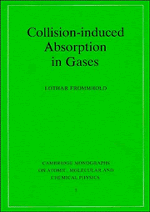2 - Recapitulation
Published online by Cambridge University Press: 23 September 2009
Summary
In this chapter we summarize some background information concerning molecular collisions, dipoles and radiation, spectroscopy, and statistical mechanics that will be needed later. This Chapter should be skipped in a first reading. It is hoped that a reader who comes back to this Chapter later with specific questions will find the answers here — or, at least, some useful reference for further study.
Intermolecular potentials
The ideal gas law, Eq. 1.1 with B = C = … = 0, may be derived with the assumption of non-interacting ‘point particles’. While in the case of rarefied gases at high temperatures this assumption is successful in that it predicts the relationship between pressure, density and temperature of a gas in close agreement with actual measurement, it was clear that important features of gaseous matter, such as condensation, the incompressibility of liquids and solids, etc., could not be modeled on that basis. As early as in 1857, Clausius argued convincingly that intermolecular forces must be repulsive at short range and attractive at long range. When in 1873 van der Waals developed his famous equation of state, a significant improvement over the ideal gas law, he assumed a repulsion like that of hard spheres at near range, and attraction at a more distant range.
- Type
- Chapter
- Information
- Collision-induced Absorption in Gases , pp. 20 - 55Publisher: Cambridge University PressPrint publication year: 1994



